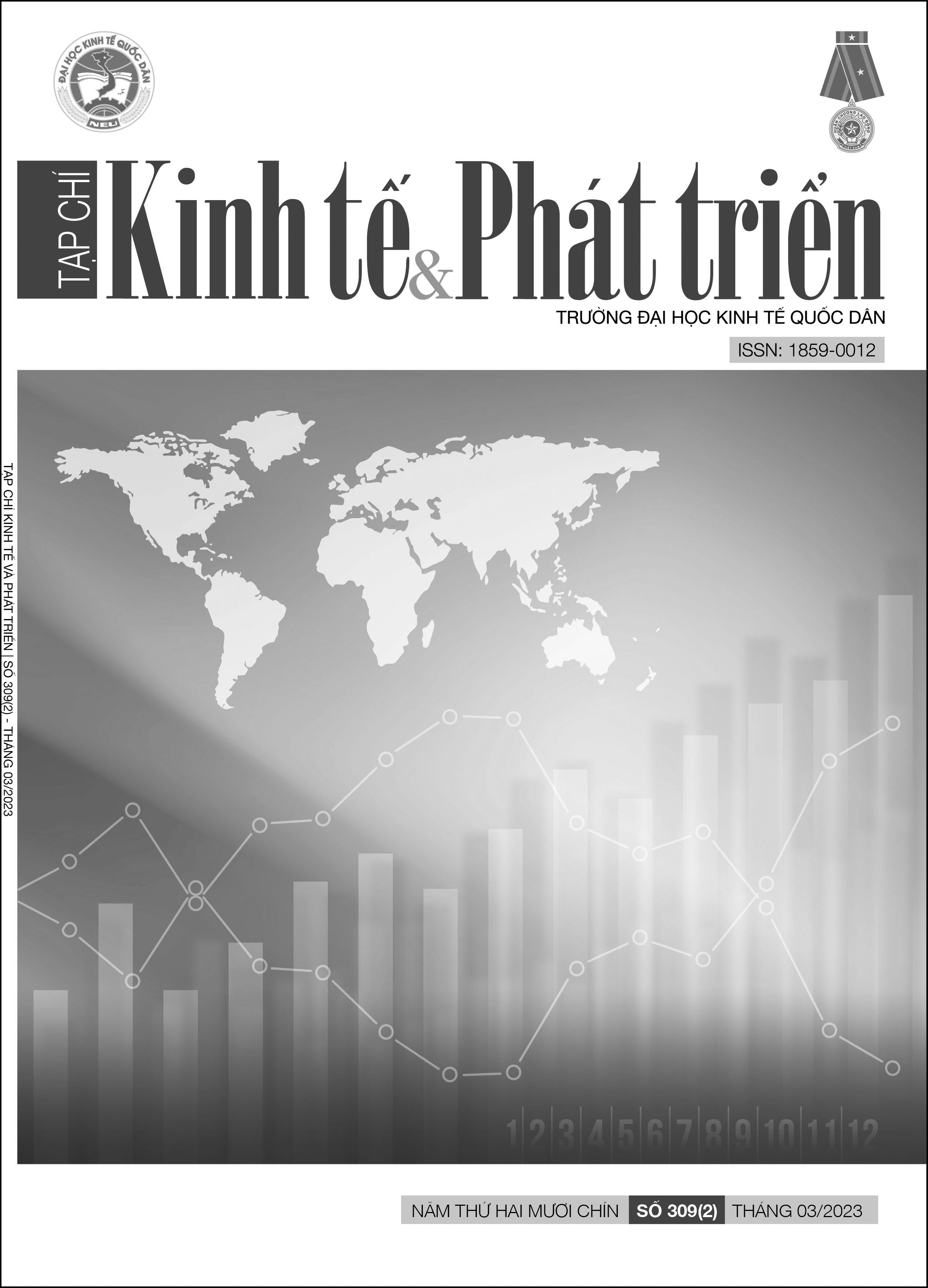Hành vi sử dụng Chatbot của thế hệ gen Z tại các ngân hàng thương mại Việt Nam
DOI:
https://doi.org/10.33301/JED.VI.1188Từ khóa:
Chatbot, công nghệ 4.0, Fintech, hành vi, ngân hàngTóm tắt
Bài viết được thực hiện nhằm tìm hiểu các yếu tố ảnh hưởng đến ý định sử dụng Chatbot trong ngân hàng của Gen Z tại thành phố Hồ Chí Minh, từ đó nêu bật tầm quan trọng của Chatbot và tăng khả năng ứng dụng của Chatbot đối với Gen Z. Dữ liệu nghiên cứu được thu thập từ 259 người và được đánh giá thông qua độ tin cậy của thang đo. Sau đó, phân tích nhân tố khám phá (EFA) và phân tích nhân tố khẳng định (CFA) được thực hiện để kiểm tra dữ liệu. Bước thứ ba là phân tích mô hình phương trình cấu trúc SEM. Kết quả nghiên cứu cho thấy các biến độc lập gồm “Chất lượng Chatbot”, “Cảm nhận tính hữu dụng", "Nhận thức dễ sử dụng", "Nhận thức rủi ro về quyền riêng tư" và "Thái độ của người dùng" đều có tác động đến ý định sử dụng Chatbot. Trong đó, thái độ có ảnh hưởng trực tiếp và mạnh nhất đến ý định sử dụng Chatbot, các yếu tố còn lại ảnh hưởng gián tiếp đến ý định sử dụng Chatbot thông qua thái độ.
Tài liệu tham khảo
Abduh, M., Duasa, J., & Omar, M. A. (2011), ‘Factors Influence Depositors’ Withdrawal Behavior in Islamic Banks: A Theory of Reasoned Action’, International Journal of Economics and Management Engineering, November 2014. https://www.researchgate.net/profile/Muhamad-Abduh/publication/267642160_Factors_Influence_Depositors’_Withdrawal_Behavior_in_Islamic_Banks_A_Theory_of_Reasoned_Action/links/545747090cf2cf516480698a/Factors-Influence-Depositors-Withdrawal-Behavior-in-Islamic-Banks-A-Theory-of-Reasoned-Action.pdf
Ajzen, I., & Driver, B. L. (1992), ‘Application of the Theory of Planned Behavior to Leisure Choice’, Journal of Leisure Research, 2216, 207–224, https://doi.org/10.1080/00222216.1992.11969889
Aldammagh, Z., Abdeljawad, R., & Obaid, T. (2021), ‘Predicting mobile banking adoption: An integration of TAM and TPB with trust and perceived risk’, Financial Internet Quarterly, 17(3), 35–46.
Alnemer, H. A. (2022), ‘Determinants of digital banking adoption in the Kingdom of Saudi Arabia : A technology acceptance model approach’, Digital Business, 2(2), 100037, https://doi.org/10.1016/j.digbus.2022.100037
Arif, I., Aslam, W., & Ali, M. (2016), ‘Students’ dependence on smartphones and its effect on purchasing behavior’, South Asian Journal of Global Business Research, 5(2), 285-302.
Blue, C. L. (1995), ‘The predictive capacity of the theory of reasoned action and the theory of planned behavior in exercise research: An integrated literature review’, Research in Nursing & Health, 105–121, https://doi.org/10.1002/nur.4770180205
Cho, M., Bonn, M. A., & Justin, J. (2018), ‘Differences in perceptions about food delivery apps between single-person and multi-person households’, International Journal of Hospitality Management, 77, 108-116, https://doi.org/10.1016/j.ijhm.2018.06.019
Conner, M., & Armitage, J. (1998), ‘Extending the Theory of Planned Behavior: A Review and Avenues for Further Research’, Journal of Applied Social Psychology, 1429–1464, https://doi.org/10.1111/j.1559-1816.1998.tb01685.x
Davis, F. D. (1985), ‘A technology acceptance model for empirically testing new end-user information systems: Theory and results’, Doctoral dissertation, Massachusetts Institute of Technology.
DeLone, W. H., & McLean, E. R. (2003), ‘The DeLone and McLean model of information systems success: a ten-year update’, Journal of Management Information Systems, 19(4), 9–30.
DeLone, W. H., & McLean, E. R. (2016), ‘Information Systems Success Measurement’, Foundations and Trends® in Information Systems, 2(1), 1–11.
DeVellis, R. F., & Thorpe, C. T. (2021), Scale development: Theory and applications, Sage publications, https://doi.org/10.1016/0886-1633(93)90012-e
Di Gaetano, S., & Diliberto, P. (2018), ‘Chatbots and Conversational Interfaces: Three Domains of Use Chatbots and Conversational Interfaces’, In Fifth International Workshop on Cultures of Participation in the Digital Age, Castiglione Della Pescaia, Italy (Vol. 2101, Pp. 62-70).
Dospinescu, O., Dospinescu, N., & Agheorghiesei, D.-T. (2021), ‘Fintech services and factors determining the expected benefits of users: Evidence in Romania for millennials and generation Z’, E&M Economics and Management, 24(2), 101–118, https://doi.org/10.15240/tul/001/2021-2-007
Gatzioufa, P., & Saprikis, V. (2022), ‘A literature review on users’ behavioral intention toward chatbots’ adoption’, Applied Computing and Informatics, https://doi.org/10.1108/ACI-01-2022-0021.
Hu, L. T., & Bentler, P. M. (1999), ‘Cutoff criteria for fit indexes in covariance structure analysis: Conventional criteria versus new alternatives’, Structural equation modeling: A multidisciplinary journal, 6(1), 1-55.
Jr, F. H. J., M., S., L., H., & G. Kuppelwieser, V. (2014), ‘Partial least squares structural equation modeling (PLS-SEM) An emerging tool in business research’, European Journal of Tourism Research, 26(2), 106–121, https://doi.org/10.3390/books978-3-0365-2621-8.
Kasilingam, D. L. (2020), ‘Technology in Society Understanding the attitude and intention to use smartphone chatbots for shopping’, Technology in Society, 62, 101280, https://doi.org/10.1016/j.techsoc.2020.101280.
López-Nicolás, C., Molina-Castillo, F. J., & Bouwman, H. (2008), ‘Information & Management An assessment of advanced mobile services acceptance: Contributions from TAM and diffusion theory models’, Information & Management, 45(6), 359–364, https://doi.org/10.1016/j.im.2008.05.001
Nguyen, X. H., Tran, H. L., Phan, H. A., Thu, T., & Phan, H. (2020), ‘Factors influencing customer satisfaction: The case of Facebook Chabot Vietnam’, International Journal of Data and Network Science, 4, 167–178, https://doi.org/10.5267/j.ijdns.2020.2.001
Pol, P., & Kl, B. (2019), ‘Education sciences Mobile Technology and Generation Z in the English Language Classroom — A Preliminary Study’, Education Sciences, 9(3), 1–11.
Richad, R., Vivensius, V., Sfenrianto, S., & Kaburuan, E. R. (2019), ‘Analysis of factors influencing millennial’s technology acceptance of chatbot in the banking industry in Indonesia’, International Journal of Civil Engineering and Technology, 10(04), 1270–1281.
Thanh, T., Duc, A., Thanh, H., & Nguyen, T. (2021), ‘Computers and Education : Artificial Intelligence NEU-chatbot : Chatbot for admission of National Economics University’, Computers and Education: Artificial Intelligence, 2, 100036, https://doi.org/10.1016/j.caeai.2021.100036
Yousafzai, S. Y., Foxall, G. R., & Pallister, J. G. (2010), ‘Explaining internet banking behavior: theory of reasoned action, theory of planned behavior, or technology acceptance model?’, Journal of Applied Social Psychology, 1172–1202, https://doi.org/10.1111/j.1559-1816.2010.00615.x





